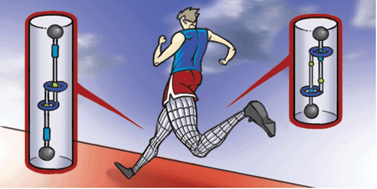During the early days of any new field, words and their definitions are born and evolve. However, as research fields grow, the terms must be locked-in to allow the discussions to move forward. This is the case in the world of artificial molecular machines as Fraser Stoddart, Bartosz Grzybowski, Dean Astumian and co-workers discuss in their fascinating Tutorial Review. The authors clearly make the distinction between a molecular switch (which are “ten a penny”) and true molecular machines (which are “few and far between”).
What is the difference? It’s all down to the ability to perform useful work. A very simplistic analogy would be an engine in a car – the pistons have been designed to move up and down but the engine can’t go anywhere. It is only when the pistons are connected to a drive shaft that the car wheels can be forced to turn and the translocation of the machine can occur. And here we come to the first challenge: the interfacing of molecular switches to the environment in such a way that they can perform useful work. Avoiding reversibility in the switch cycle is key, but unfortunately this blog post is too short to get into the full details…
One molecular switch that is interfaced to its environment can do useful work at its own scale, but what about the macroscopic scale? To achieve this, there is a need to spatially and sometimes temporally organise the switches, just like in nature. How can this be done? The authors suggest that metal–organic frameworks may hold the key to this particular challenge.
What is particularly interesting in the field as a whole is the efficiency that energy can be converted into useful work. Potentially, this could be anywhere from 75% to close to 100%. When compared to the efficiency of a car engine (20–30%), it is spectacular. The reason for this is that chemical free energy can be directly converted into mechanical work, without having to be converted to heat energy first. The possible uses of artificial molecular machines are truly ground-breaking and the creation of a nanoscale robotic arm which shows precise positional control cannot be far off. Whoever is first can claim Feynman’s Grand Prize of $250,000, which should cover some lab expenses as well as a bottle of champagne or two!
This Tutorial Review clearly states the distinction between switches and machines and sets out the challenges facing the field in the years to come. Stoddart and Grzybowski’s roadmap should provide a useful guide to all researchers in this particularly exciting discipline of chemistry. It is time for the switches to be hooked up and useful work to be extracted.
To find out more, download the Chem Soc Rev article today.
Posted on behalf of Iain Larmour, Chem Soc Rev web science writer.











